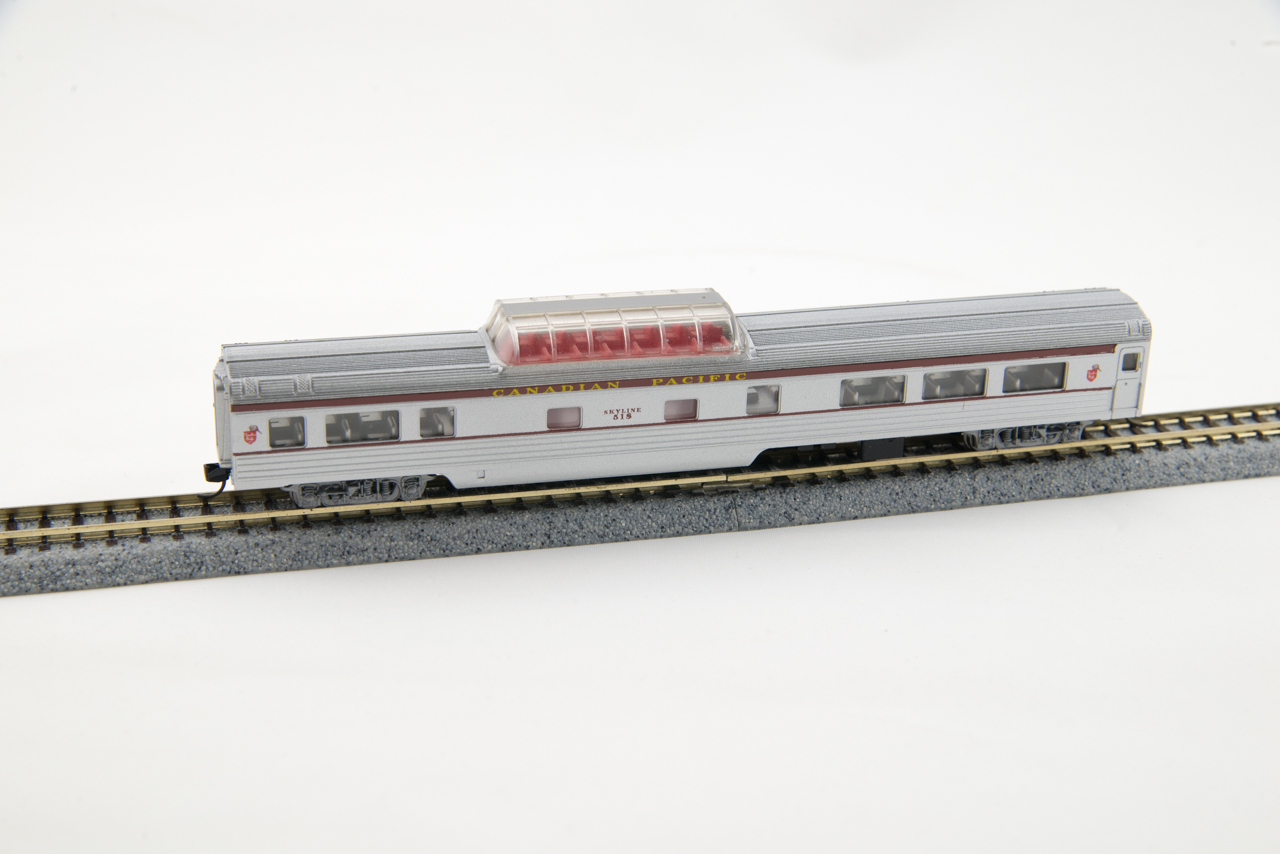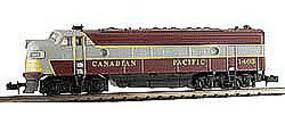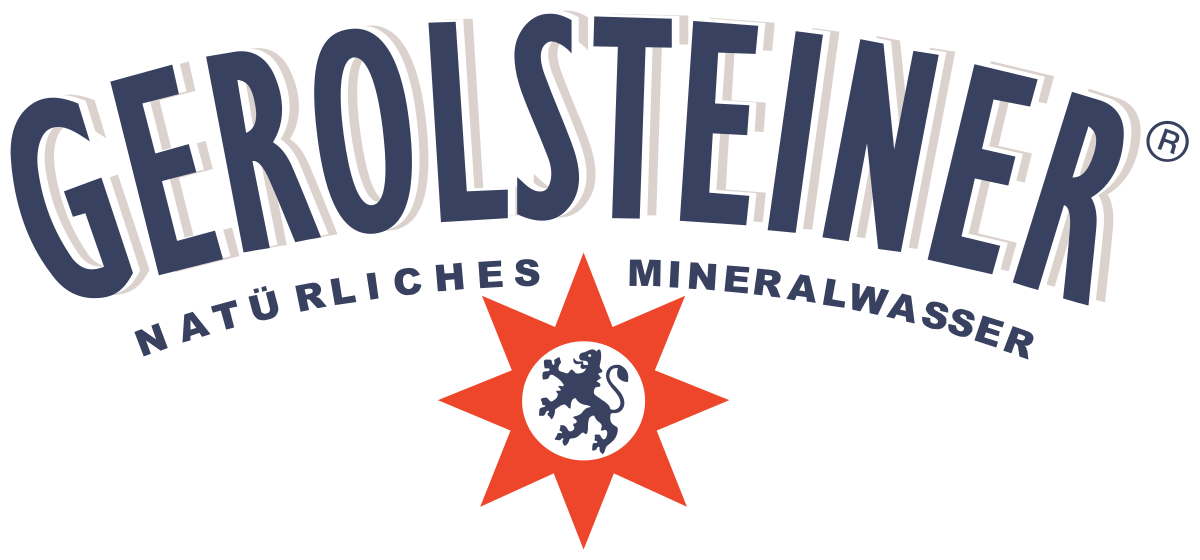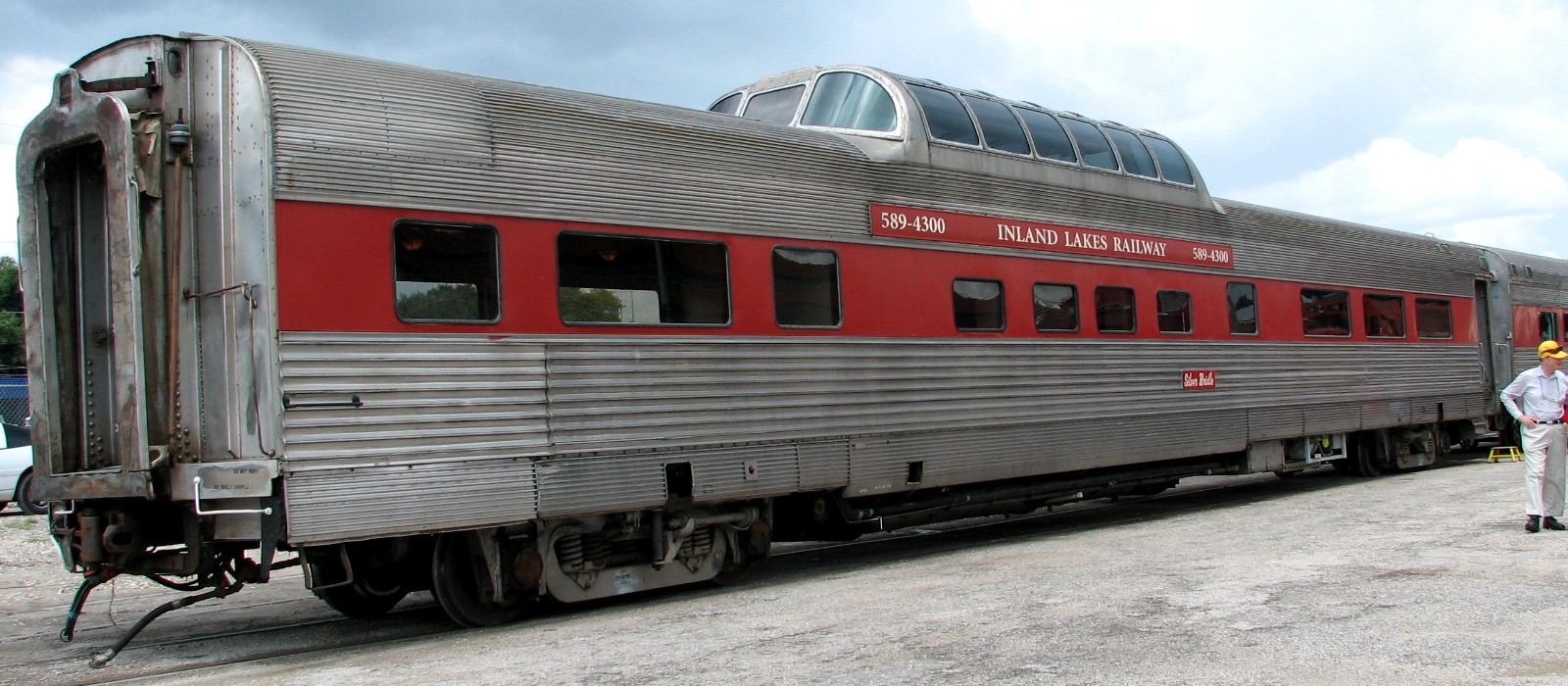Model Information: This car is a bit of an odd-ball. It was apparently originally made in the 1970s by Kato for Con-Cor. Early examples are labeled Sekisui/Con-Cor Japan. Later examples have the label milled out and replaced with 'Con-Cor'. This would presume that the tooling was moved from Japan to the United states at some point.
Early versions came in kit form with Rapido couplers. Later versions are Ready-to-Run (RTR) and come with either dummy knuckle "Rigid Face" couplers or Micro-Trains couplers.
It is modeled after the 46-seat dome-coach built by Budd for the CB&Q (Burlington Route) in 1956 to run on the Denver Zephyr (DZ). It is very similar to the 46-seat dome-coach built by Budd for Great Northern’s 1955 Empire Builder, the latter having “slab panel” sides instead of corrugated sides.
Despite the model having corrugated sides, Con-Cor marketed and packaged it either as a 'Corrugated Dome' (stainless steel finish) or a 'Smoothside Dome' (painted finish). The Con-Cor literature refers to it as a 'mid-train dome', which means it is not a dedicated tail car and can be used between other passenger cars.
Yet, in spite of the Con-Cor labeling and manufacturing , the Con-Cor website sometimes refers to this model as a 'Rivarossi Corrugated Dome', with a stock number starting with 0003- or 003- that is the company prefix used by Con-Cor for Rivarossi products. This is actually to complement the Rivarossi lightweight corrugated range that is missing a dome car, in particular in the Con-Cor/Rivarossi 5-car corrugated passenger sets.
So, though the 'corrugated' and 'smoothside' versions are marketed with different denominations by Con-Cor, they are technically of the same model type, hence are all regrouped in this single body style.
Warning: Con-cor designed subsequently another mid-train corrugated dome, inspired by another Budd dome built for the California Zephyr, that is not to be confused with this one.
Early versions came in kit form with Rapido couplers. Later versions are Ready-to-Run (RTR) and come with either dummy knuckle "Rigid Face" couplers or Micro-Trains couplers.
It is modeled after the 46-seat dome-coach built by Budd for the CB&Q (Burlington Route) in 1956 to run on the Denver Zephyr (DZ). It is very similar to the 46-seat dome-coach built by Budd for Great Northern’s 1955 Empire Builder, the latter having “slab panel” sides instead of corrugated sides.
Despite the model having corrugated sides, Con-Cor marketed and packaged it either as a 'Corrugated Dome' (stainless steel finish) or a 'Smoothside Dome' (painted finish). The Con-Cor literature refers to it as a 'mid-train dome', which means it is not a dedicated tail car and can be used between other passenger cars.
Yet, in spite of the Con-Cor labeling and manufacturing , the Con-Cor website sometimes refers to this model as a 'Rivarossi Corrugated Dome', with a stock number starting with 0003- or 003- that is the company prefix used by Con-Cor for Rivarossi products. This is actually to complement the Rivarossi lightweight corrugated range that is missing a dome car, in particular in the Con-Cor/Rivarossi 5-car corrugated passenger sets.
So, though the 'corrugated' and 'smoothside' versions are marketed with different denominations by Con-Cor, they are technically of the same model type, hence are all regrouped in this single body style.
Warning: Con-cor designed subsequently another mid-train corrugated dome, inspired by another Budd dome built for the California Zephyr, that is not to be confused with this one.
Prototype History: A dome car is a type of railway passenger car that has a glass dome on the top of the car where passengers can ride and see in all directions around the train. It also can include features of a coach, lounge car, dining car, sleeping car or observation. Beginning in 1945, dome cars were primarily used in the United States and Canada, though a small number were constructed in Europe for Trans Europ Express service, and similar panorama cars are in service on Alpine tourist railways like the Bernina Express.
In North America, dome cars were manufactured by the Budd Company, Pullman Standard and American Car & Foundry. Southern Pacific Railroad built its own dome cars in its Sacramento, California, shops. In the 1990s Colorado Railcar began producing dome cars. Generally, seats in the dome were considered "non-revenue" like lounge car seats. When dome cars operate today in excursion trains, the dome seats often command a premium fare.
In North America, dome cars were manufactured by the Budd Company, Pullman Standard and American Car & Foundry. Southern Pacific Railroad built its own dome cars in its Sacramento, California, shops. In the 1990s Colorado Railcar began producing dome cars. Generally, seats in the dome were considered "non-revenue" like lounge car seats. When dome cars operate today in excursion trains, the dome seats often command a premium fare.
Road Name History: The Canadian Pacific Railway (CPR), formerly also known as CP Rail (reporting mark CP) between 1968 and 1996, is a historic Canadian Class I railroad incorporated in 1881. The railroad is owned by Canadian Pacific Railway Limited (TSX: CP, NYSE: CP), which began operations as legal owner in a corporate restructuring in 2001.
Headquartered in Calgary, Alberta, it owns approximately 23,000 kilometres (14,000 mi) of track all across Canada and into the United States, stretching from Montreal to Vancouver, and as far north as Edmonton. Its rail network also serves major cities in the United States, such as Minneapolis, Milwaukee, Detroit, Chicago, and New York City.
The railway was originally built between Eastern Canada and British Columbia between 1881 and 1885 (connecting with Ottawa Valley and Georgian Bay area lines built earlier), fulfilling a promise extended to British Columbia when it entered Confederation in 1871. It was Canada's first transcontinental railway, but currently does not reach the Atlantic coast. Primarily a freight railway, the CPR was for decades the only practical means of long-distance passenger transport in most regions of Canada, and was instrumental in the settlement and development of Western Canada. The CP became one of the largest and most powerful companies in Canada, a position it held as late as 1975. Its primary passenger services were eliminated in 1986, after being assumed by Via Rail Canada in 1978. A beaver was chosen as the railway's logo because it is the national symbol of Canada and was seen as representing the hardworking character of the company.
The company acquired two American lines in 2009: the Dakota, Minnesota and Eastern Railroad and the Iowa, Chicago and Eastern Railroad. The trackage of the ICE was at one time part of CP subsidiary Soo Line and predecessor line The Milwaukee Road. The combined DME/ICE system spanned North Dakota, South Dakota, Minnesota, Wisconsin, Nebraska and Iowa, as well as two short stretches into two other states, which included a line to Kansas City, Missouri, and a line to Chicago, Illinois, and regulatory approval to build a line into the Powder River Basin of Wyoming. It is publicly traded on both the Toronto Stock Exchange and the New York Stock Exchange under the ticker CP. Its U.S. headquarters are in Minneapolis.
After close of markets on November 17, 2015, CP announced an offer to purchase all outstanding shares of Norfolk Southern Railway, at a price in excess of the US$26 billion capitalization of the United States-based railway. If completed, this merger of the second and fourth oldest Class I railroads in North America would have formed the largest single railway company on that continent, reaching from the Pacific coast to the Atlantic coast to the Gulf Coast. The merger effort was abandoned by Canadian Pacific on April 11, 2016, after three offers were rejected by the Norfolk Southern board.
Read more on Wikipedia and on Canadian Pacific official website.
Headquartered in Calgary, Alberta, it owns approximately 23,000 kilometres (14,000 mi) of track all across Canada and into the United States, stretching from Montreal to Vancouver, and as far north as Edmonton. Its rail network also serves major cities in the United States, such as Minneapolis, Milwaukee, Detroit, Chicago, and New York City.
The railway was originally built between Eastern Canada and British Columbia between 1881 and 1885 (connecting with Ottawa Valley and Georgian Bay area lines built earlier), fulfilling a promise extended to British Columbia when it entered Confederation in 1871. It was Canada's first transcontinental railway, but currently does not reach the Atlantic coast. Primarily a freight railway, the CPR was for decades the only practical means of long-distance passenger transport in most regions of Canada, and was instrumental in the settlement and development of Western Canada. The CP became one of the largest and most powerful companies in Canada, a position it held as late as 1975. Its primary passenger services were eliminated in 1986, after being assumed by Via Rail Canada in 1978. A beaver was chosen as the railway's logo because it is the national symbol of Canada and was seen as representing the hardworking character of the company.
The company acquired two American lines in 2009: the Dakota, Minnesota and Eastern Railroad and the Iowa, Chicago and Eastern Railroad. The trackage of the ICE was at one time part of CP subsidiary Soo Line and predecessor line The Milwaukee Road. The combined DME/ICE system spanned North Dakota, South Dakota, Minnesota, Wisconsin, Nebraska and Iowa, as well as two short stretches into two other states, which included a line to Kansas City, Missouri, and a line to Chicago, Illinois, and regulatory approval to build a line into the Powder River Basin of Wyoming. It is publicly traded on both the Toronto Stock Exchange and the New York Stock Exchange under the ticker CP. Its U.S. headquarters are in Minneapolis.
After close of markets on November 17, 2015, CP announced an offer to purchase all outstanding shares of Norfolk Southern Railway, at a price in excess of the US$26 billion capitalization of the United States-based railway. If completed, this merger of the second and fourth oldest Class I railroads in North America would have formed the largest single railway company on that continent, reaching from the Pacific coast to the Atlantic coast to the Gulf Coast. The merger effort was abandoned by Canadian Pacific on April 11, 2016, after three offers were rejected by the Norfolk Southern board.
Read more on Wikipedia and on Canadian Pacific official website.
Brand/Importer Information: Con-Cor has been in business since 1962. Many things have changed over time as originally they were a complete manufacturing operation in the USA and at one time had upwards of 45 employees. They not only designed the models,but they also built their own molds, did injection molding, painting, printing and packaging on their models.
Currently, most of their manufacturing has been moved overseas and now they import 90% of their products as totally finished goods, or in finished components. They only do some incidental manufacturing today within the USA.
Important Note: The Con-Cor product numbering can be very confusing. Please see here in the article how to properly enter Con-Cor stock numbers in the TroveStar database.
Currently, most of their manufacturing has been moved overseas and now they import 90% of their products as totally finished goods, or in finished components. They only do some incidental manufacturing today within the USA.
Important Note: The Con-Cor product numbering can be very confusing. Please see here in the article how to properly enter Con-Cor stock numbers in the TroveStar database.
Item created by: CNW400 on 2020-06-15 10:46:02
Last edited by: Alain LM on 2020-11-24 15:10:40
If you see errors or missing data in this entry, please feel free to log in and edit it. Anyone with a Gmail account can log in instantly.
Last edited by: Alain LM on 2020-11-24 15:10:40
If you see errors or missing data in this entry, please feel free to log in and edit it. Anyone with a Gmail account can log in instantly.











